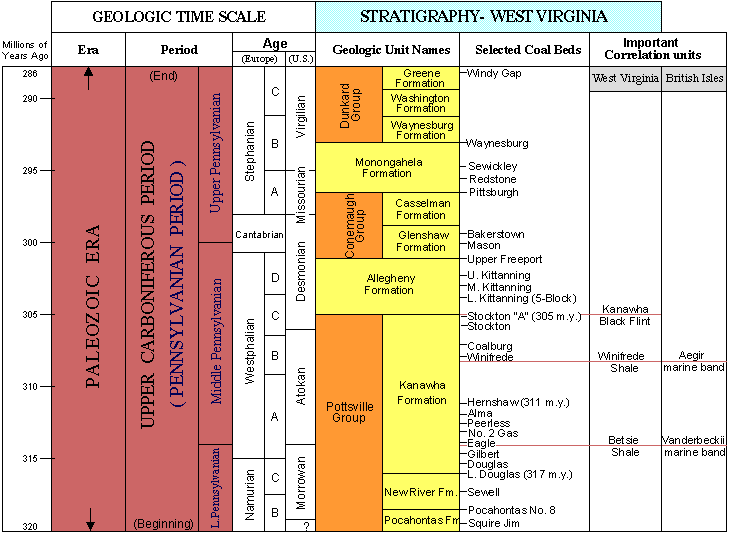The Pennsylvanian Period began 320 million years ago and ended 286 million
years ago. Throughout this period, vast low-lying coastal swamps and deltas
covered much of West Virginia and the eastern and midwestern U.S., creating
conditions ideal for coal formation. In West Virginia seams with names
like Pittsburgh, Pocahontas, Eagle, and Sewell, were deposited. The geologic
units and coal seams listed below are nomenclature currently used in West
Virginia
The Kanawha Formation was deposited in West Virginia during the Middle Pennsylvanian Period, and yields 26 of the 62 minable coal seams officially identified in West Virginia. Most of the specimens displayed in Plant Fossils of West Virginia are from this formation.
 |
| after West Virginia Geological Survey, 2002, and A Geologic Time Scale; Cambridge Earth Press, 1982 |
Recent work by the West Virginia Geological Survey dates the upper and
lower boundaries of the Kanawha Formation at 305 million years and 317
million years, respectively. During this 12,000,000 year time span approximately
1200 feet of rock formations were laid down. This works out to an average
depositional rate of 1 foot of rock every 10,000 years.
Deposition rates were anything but uniform and constant. For example, fossilized trees are sometimes observed in surface mine highwalls buried in a standing position, sometimes 30-feet high or more, attesting to very rapid burial rates. Directly underneath may be a coal seam several feet thick, which attests to extremely quiet conditions in which virtually no sediments were deposited for tens of thousands of years.
Recent work in the Hernshaw (also known as Fireclay) seam by Allen Kiser and others of the WVGS establishes an absolute radiometric age date of 311 million years, +/- 1.5 million years. This date was determined from a thin but distinctive tonstein parting _found in the seam. A tonstein parting makes an excellent correllation marker bed because deposition was relatively instantaneous over a fairly wide geographic area, and also because tonsteins contain radioactive elements which can be dated fairly precisely.
Usually only a few centimeters thick, tonstein partings are derived from the altered ash of volcanos. During the Pennsylvanian Period the continental plates of Africa, Europe, and North America were in collision, forming volcanic mountain ranges along their margins as oceanic crust was subducted under the relatively lighter continental crust. This process goes on today around the perimeter of the Pacific Ocean in the volcanically and seismically active belt known as the "ring of fire", where volcanos including Mt. St. Helens, Mt. Ranier, Mt. Fuji, etc. belch every once and a while, but for the most part are relatively well-behaved.
Sometime during the Triassic Period, the collision was complete, and
the supercontinent of Pangea
was formed. The Pangean mountain- building supplied sediments which began
forming deltas in southeastern West Virginia during the early Pennsylvanian
Period, and through continual shoreline accretion gradually pushed the
coastline northwestward into northern West Virginia by the end of the Pennsylvanian
Period. For this reason the oldest of these coal seams, such as the Pocahontas
and Sewell seams, are only found in the southern part of the state and
the youngest seams, like the Pittsburgh, are found only in the northern
part.
| |
|
| || Articles || | Table of Contents || |